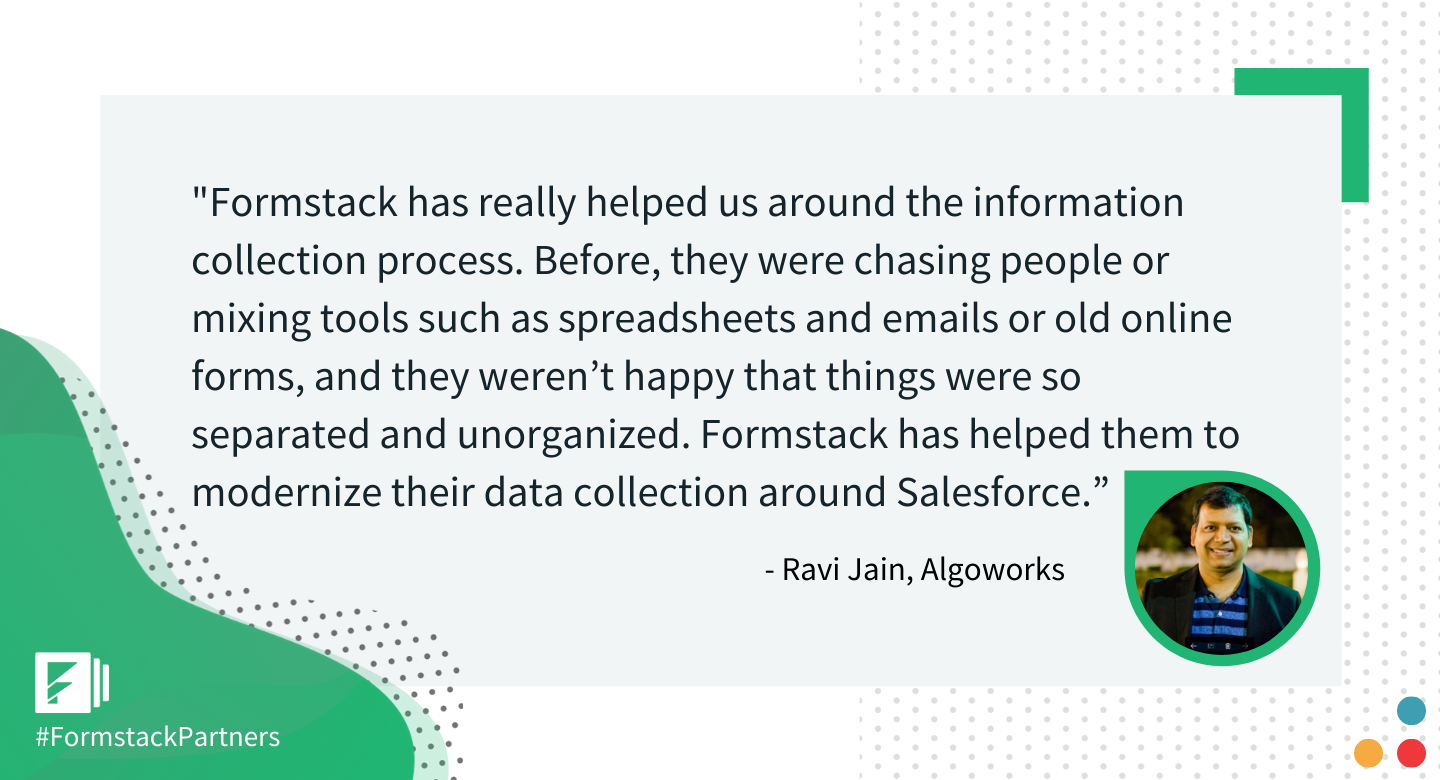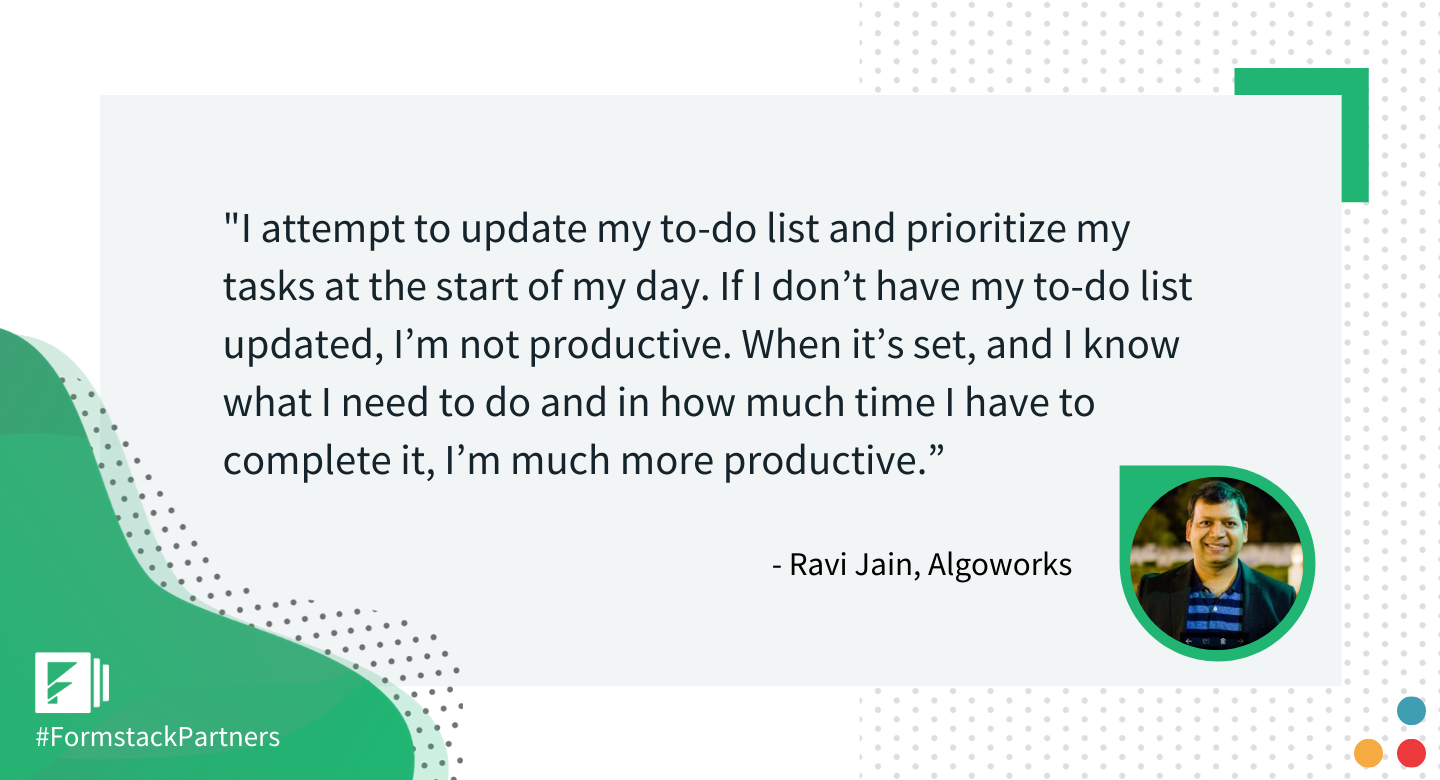Our VP of Partnerships Zak Pines recently sat down with Ravi Jain, Director & Global Head of Salesforce and Analytics at Algoworks, as part of our ongoing Partner Interview Series. Zak and Ravi had a far-ranging conversation that touched on the Algoworks story; how Salesforce helps improve business processes; and working with Formstack for forms, document automation, and eSignature for Salesforce. Here’s an abridged transcript of the chat.
Background on Algoworks
Zak: Can you start by telling me about Algoworks and how you position the business?
Ravi: We are a technology company providing end-to-end product development services globally. With our product engineering and agile delivery process, we help deliver robust software products in the shortest time to market. Our key IT service offerings include building enterprise-grade solutions for Salesforce and mobility as well as providing services on DevOps and enterprise application integration. We are recognized partners with 80+ businesses worldwide, including Fortune 500 companies like Amazon, Dell, Salesforce, and Microsoft.
Zak: You’ve been with Algoworks for three years. What specifically is your role?
Ravi: I’m heading the Salesforce and Analytics practices at Algoworks. I’m the Global Head for both. The work is immense, and the intensity drives me!
I drive the business strategy for both practices, build the vision and roadmap of AppExchange applications, and am also responsible for client acquisition and retention. I focus on skills development of my team. Salesforce is growing, and when they bring on new features and capabilities, we need to keep our team up to date and knowledgeable of those new aspects of the product. For a few larger customers, I play the role of solution architect as well.
Zak: Do you recall when you first got introduced to Salesforce?
Ravi: At Aon Hewitt I wasn’t heading the Salesforce practice. Instead, I focused on data intelligence and analytics. But I had a good friend managing Salesforce, and we generally talked about what it is and how it works. I became interested in knowing the product, what’s happening in the market, and how the product impacts businesses.
It was around this time when the founders of Algoworks approached me with this opportunity. It was a big change moving from a big corporate culture to a smaller firm, but I’m enjoying it because you get to do a lot in a firm like Algoworks. You explore some of your potential for other aspects of the business. That doesn’t happen as much with a large-scale organization.
Zak: From a role perspective, who are the typical stakeholders you work with in a customer’s organization?
Ravi: I can only speak from the lense of Salesforce and the analytics, as they are the two practices I manage. Based on my experience, we deal with Salesforce admins, sales, marketing, operations, and their IT teams. Roles range from department heads to directors to managers and then their architects as well.
There are clients who have operations teams who look for scalability and flexibility as part of their delivery offering. And there are clients who don’t have technology capabilities, while their core business isn’t related to technology at all. They’re a product or a solution and aren’t looking to focus on building a technology team, so they want to focus on their core strengths and want to offload that kind of work to us.
Zak: So customers tend to come to you because they’re looking for more bandwidth and more specialized resources to help with a project?
Ravi: Primarily, yes. Then there are also cases where they don’t have these capabilities in house, but they want to build a certain solution or product in Salesforce—or they have a problem they want to solve for within Salesforce—so they look for a Salesforce consulting partner to collaborate with and help them.
Standardized vs. Customized Implementations
Zak: When you think about the opportunity to help a customer automate their business processes around Salesforce, what are some of the pain points or opportunities you tend to see around helping your customers?
Ravi: There are two broader objectives when a customer comes to us looking to implement Salesforce into their business. First, they try to re-engineer their business processes to align with what Salesforce recommends. Secondly, their mindset is that the business is dependent on a customized business process. This latter option means that they already believe their business is efficient and don’t want to change, but they’re bringing in Salesforce to solve a problem. When the customer is not willing to change their business processes, it’s tough because they want the application to fit into their mold. In these cases though, we jump in, consult, and help build new features and functionalities to reflect the business flow the customer wants. We ultimately advise our clients to follow the best Salesforce practices. If they’re going to invest in Salesforce, they should follow its standardized processes.
Zak: Yes, I’ve seen the downside of overly customized CRM implementations. When it comes to maintenance and scalability, standardized product solutions lead you to something much more adaptable and effective for your business.
Ravi: Correct. We are in this business to stay, and that’s possible when we build relationships with our customers by investing in their future, besides completing the project. The whole purpose of leveraging an out-of-the-box cloud-based solution is to make their business more efficient. And while it’s a big change up front, it’s worth it. You also need to keep investing money and maintenance on upgrades, but from an organizational level where you have a large set of users—hundreds or thousands of users, for example—Salesforce can come in and help realign your organization across the board.
Another thing to keep in mind is when you invest in a new tool, you revamp and update your documents and trainings and have to roll out these new processes and remove the older documentation. This means that businesses should spend the time up front to ensure they’re ready for an implementation like this in the first place, which is one of the services we provide. A consulting and discovery approach with the customer allows us to do the analysis and provide them with a view in terms of what can go into making the switch. There on, we take over all their headaches.
Algoworks and Formstack
Zak: So Ravi, do you recall when you first were introduced to Formstack?
Ravi: Of course I do. It has been almost a year. Some of our leaders met at Dreamforce last year. We got introduced to your partner program, and the rest, as they say, is history.
Zak: Are there any projects that stand out to you?
Ravi: There are multiple projects I could think of, but there’s one in particular with a large company with whom we have a long-standing, established relationship. We have been building lots of internal, custom solutions to improve their overall business efficiencies. We were engaged in building Salesforce applications and solutions for their internal team to improve their business processes.
Formstack has really helped us around the information collection process. Before, they were chasing people or mixing tools such as spreadsheets and emails or old online forms, and they weren’t happy that things were so separated and unorganized. Formstack has helped them to modernize their data collection around Salesforce.

Zak: Interesting you mention that. We have the native forms product that you’re speaking of for data collection, and now we’ve introduced Formstack Documents for data-driven documents and Formstack Sign for eSignature capabilities. So it’s about helping customers create a more efficient business process around Salesforce.
Ravi: Yes, that’s exactly right Zak, and we do have customers looking for streamlining their processes. A product that brings together all of their needs is the ultimate solution. A bundle that brings together three different products handling forms, document creation, and eSignature is a big plus.
That’s where we advocate for Formstack as a product. We know its capabilities, and we can talk about it with lots of experience and confidence to our customers. Formstack positioning as a one-stop shop is something we advocate to our clients. If it’s the best option a customer can get, why not?
Zak: You mentioned Formstack Documents, formerly WebMerge. What are some of the document use cases you come across where customers are looking to create dynamic or data-driven documents?
Ravi: The common use cases I’ve seen are around contract generation or proposal generation. It’s about building nicely formatted documents, having merge fields populating dynamically from Salesforce, showing the data in a tabular format, for instance, and showing all product line items that the client is looking for. In general, creating documents is a recurring need for our clients, and we like that your product allows users to do that at the click of a button.
Zak: Yes, the click of a button. Gabe on our team refers to that as the “easy button.”
Lightning Round
Zak: Let’s wrap up with the lightning round. Do you have any personal interests or hobbies?
Ravi: I recently found interest in working out, and that is helping me in more ways than I could have imagined. I’ve also started watching some shows that have caught my interest. And while hanging out with friends is still a thing, the rest of my time is for my family.
Zak: We’re all increasingly busy these days. Do you have any productivity tips you can share?
Ravi: I attempt to update my to-do list and prioritize my tasks at the start of my day. If I don’t have my to-do list updated, I’m not productive. When it’s set, and I know what I need to do and in how much time I have to complete it, I’m much more productive.

Zak: What’s your favorite TV show?
Ravi: I’m a big time fan of “Everybody Loves Raymond.” I was binge watching “Boston Legal” and “Monk” prior to that.
Zak: What’s your go-to lunch during the work day?
Ravi: It’s the delicious North Indian cuisine my wife and I cook at home that I carry to work.
Zak: We have a debate within Formstack and want you to weigh in. Is a hot dog a sandwich?
Ravi: I don’t know! It could be. There are two pieces of bread, and you put your sausage in between, so it’s got to be a sandwich. I wonder if anyone will ever find out.
Zak: Well I haven’t gotten that answer before! Thanks for your time Ravi. We appreciate our collaboration.
Looking for your next step? Check out Formstack’s partner program for consultants, agencies, and tech partners.











